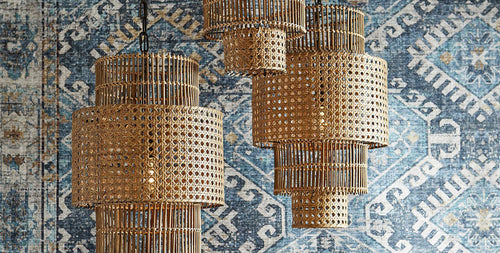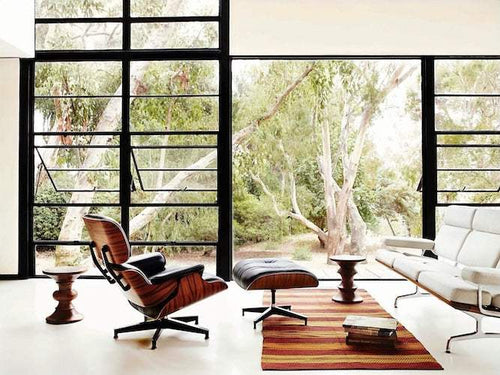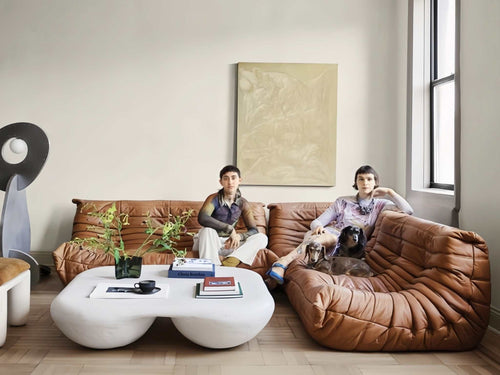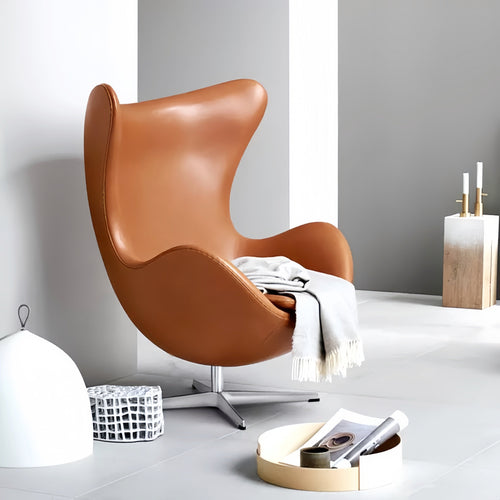
Furniture is for experience, just as paintings are for appreciating and fashion is for wearing. Furniture has long outlived its functionality and evolved into creative ornamentation. Not only can it embellish the surroundings and showcase style, but it also has the power to alter our living environment and shape our daily moods. This is the allure of design.
In contrast to pure art, industrial design is a medium in which form nearly always comes after function. This is especially true in the case of furniture design. Technology and art work together to achieve an unsurpassed aesthetic connotation while maintaining functional perfection.
A truly good design is long-lasting, and it develops a durable quality with time. We explore some of the most iconic classic furniture designs in contemporary design history in this issue.
Classic indicates that you can have your own distinct style even in different eras. They permeate our lives today, surpassing temporal, spatial, and cultural boundaries. Every iconic design has a unique backstory, rich heritage, and heartfelt story. Classic furniture may have the soul of timelessness.
NO.01
Eames Lounge Chair and Ottoman
Designer: Charles and Ray Eames

Despite endless design lists, the 1954 Eames bentwood lounge chair remains the most influential design masterpiece of the twentieth century, perfectly blending modern industrial technology with traditional craftsmanship.

In the twentieth century, the motto "Design for Life" was popular in the design field. Charles and Ray Eames were the primary promoters. They established furniture design as a new trend as the most significant pioneer designers in the field of modern design.

This lounge chair exemplifies their unwavering pursuit of usefulness and elegance. It is trendy, fashionable, attractive, and uncomplicated while providing comfort and functionality. It may quickly improve the atmosphere in whatever space it is placed in.
The Eames Lounge Chair is in the permanent collection of the Museum of Modern Art in New York.

NO.02
Arco Floor Lamp
Designer: Achille Castiglioni
The iconic Italian industrial design genius Achille Castiglini created several unique and significant classics, including this Arco Floor Lamp.

ARCO was created to replace restaurant chandeliers. Because it is not possible to cut holes in the ceiling to install lamps in many protected structures in Italy, we investigated employing a parabolic form to obtain the same lighting effect.

The marble base, slender parabolic hanging rod, and circular lampshade are merged like an avant-garde sculpture, giving the area an instantly attractive character similar to that of an art gallery.

NO.03
Tulip Table

Eero Saarinen, the most innovative architect and industrial designer in the United States during the twentieth century, combined a high level of craftsmanship with a strong sense of the times. He not only addressed design issues, but also took into account the visual environment that the furniture in the area created, making it distinct.

The ugly and dirty legs of furniture are supposed to be the most unbearable thing for Saarinen, hence this series of narrow tulips supported on one leg was produced.

The Tulip series, Saarinen's most classic design, employs a single column foot that extends downwards to a drop-shaped base, and the seat is carved with streamlined flower lines that bloom beautifully like petals or wine glasses.

Tulips are available in a variety of heights, surface diameters, colours, and materials. With its own spatial character, it has remained an unrivalled classic in the field of furniture design to this day.

NO.04

There are many iconic chair designs in the world, but only one is truly "Diamond."

Sculptor Harry Bertoia created the Diamond Chair. Since its inception, its light and graceful shape has been widely sought after. It is not simply a collector's favourite, but also a frequent visitor to classic cinema festivals. It has been a best-seller for almost a half-century and is considered a timeless classic.

Excellent metal technology welds the Diamond Chair into a modern minimalist furniture design style. The Diamond Chair boasts simple lines, an exquisite design, is light and functional, and has a diamond-like shine. It's more of a sculpture and a work of art in space than a seat.

NO.05

The Anglepoise table lamp is the most iconic lamp of the twentieth century, as well as one of the most copied and reproduced objects in design history. Consider the jumping light at the beginning of a Pixar animation, you've probably seen it.

George Carwardine, a Britishman, invented the desk lamp. As an engineer researching vehicle shock absorption systems, he inadvertently inserted an experimental spring on the end of a work light to enable lamp arm adjustment and preserve balance.

Herbert Terry & Sons of Redditch, a spring manufacturer, recognised its commercial potential and began mass manufacturing in 1933. Due to its basic appearance and practical features, the Anglepoise table lamp is considered a classic of industrial design.

NO.06
Panton Chair
Designer: Verner Panton

Wiener Pantone was known as "the most imaginative design master of the twentieth century" because he enjoyed experimenting with colours and materials. The design pieces are all eye-catching, from furniture to space, from material to shape.

Inspired by stacked plastic barrels, the Pantone Chair is the world's first one-piece injection-molded plastic cantilever chair.
The thin S-shaped side profile resembles a woman wearing a floor-length skirt. The vibrant colours are stunning and graceful, and the rhythmic curves are light and elegant, earning it the nickname "Beauty Chair."
Even in black, the beautiful curves are noble and dignified, thin and appealing, and complement each other whether matched with modern or traditional interiors.

NO.07
Nelson Saucer Bubble Pendant
Designer: George Nelson

The cross bubble chandelier is a collection of colourful lamps with wonderful spherical contours. It is regarded as the most iconic lamp design series by American modernist design master Nelson, and it has endured over time.
According to reports, Nielsen fell in love with a set of Swedish chandeliers but couldn't afford them, so the design master decided to create his own lighting.
This is how the Bubble Pendant came to be: a spherical frame of lightweight steel coated in a smooth translucent covering. The lighting is delicate and elegant, with a light and flowing romantic ambiance.

NO.08
Serpentine Sofa
Designer: Vladimir Kagan
In a world dominated by straight-line sofas, famed designer Vladimir Kagan's "Serpentine Sofa" with its exquisite streamlined form and soft texture is undeniably rebellious.

In a world where straight-line sofas rule, famed designer Vladimir Kagan's "Serpentine Sofa" with its exquisite streamlined form and soft texture is undeniably subversive.

The curving design not only offers a cosy meeting spot, but it also defines the space's warm, elegant, and fun tone. Since then, every celebrity interior design space has had a snake-shaped sofa.

NO.9
Up5 Armchair & Ottoman
Designer: Gaetano Pesce for B&B Italia
This sofa by Gaetano Pesce, an Italian designer, is rich with sensory and figurative overtones. Its lush and beautiful shape appears to return to mother's warm embrace. It is known as "Up 5".
Pesce's devotion for his Latin nation roused the visual nerves in a volatile and strong era. Chains shackle the allegedly plump and attractive body, and the childlike ball hangs like a shackle.
"I believe that women are always very unwilling prisoners of themselves," Pesce says. So I decided to make the armchair in the shape of a woman, complete with chains and balls, as if she were a life prisoner."

This sofa is both provocative and eye-catching. This sofa's circular and complete shape stimulates the senses, making it a timeless design classic and the ultimate focal point of the space.

NO.10
Wassily(Model B3)Chair
Designer: Marcel Breuer

Breuer was a pioneer in steel tube furniture design as well as a master of modernist design and architecture. The Vasily Chair, the world's first steel tube chair, is perhaps the most well-known. Wassily Kandinsky, a Russian painter, inspired the name.

The handlebars of Adler's bicycles served as inspiration for the design of the Vasily Chair. It employs metal bending processing technologies to produce a basic and streamlined design that is timeless.
Unlike traditional enveloping seats, the Wassily chair's seat cushion, backrest, and armrests are all flat surfaces. The curved steel tubes provide an open deconstruction, and the various angles between the flat surfaces create a self-explanatory aesthetic.

The Wassily chair, which is simple and harmonious, blends practicality, beauty, and economy by relying on the extraordinarily high plasticity and economy of metal steel pipes. The Vasily chair appears to blend gracefully into any room, whether it is an ancient house with classic décor or a modern one.

NO.11
Bauhaus Nesting Side Tables
Designer: Josef Albers

The renowned German design school Bauhaus champions the "Less is more" philosophy, striving to portray a pure and authentic spatial aesthetic. Geometric shapes, primary colour schemes, and minimal accessories are straightforward and clear.

Josef Albers, the artistic director of the Bauhaus furniture company, designed this set of stacking side tables as the pinnacle of minimalism, employing only the simplest geometric elements to achieve the transition from planar to three-dimensional.

Each table is comprised of lacquered acrylic glass and oak wood. Albers used a vibrant artistic flair in the furniture design, giving each table a distinct colour palette of blue, red, yellow, and white.
This detachable and integrated approach also inspired a series of stacked tables and chairs.

NO.12
Florence Knoll Sofa
Designer: Florence Knoll

Florence Knoll was a Bauhaus-influenced designer who concentrated on furthering the use of architecture, art, and functionality in the realm of interior design. He is often recognised as the twentieth century's most significant design figure.

With its simple and beautiful lines and free and flexible combination ways to satisfy the ever-changing functional needs of modern space, the Florence classic office sofa has become a recognised sofa classic since its debut.

NO.13
LC4 Chaise Longue
Designer: Le Corbusier, Pierre Jeannerret, Charlotte Perriand

With its ideal combination of geometric shape and ergonomics, this iconic lounge chair built under the direction of Swiss architectural design master Le Corbusier can be regarded as a prominent work of "functionalism" in modern home design.

The goal is to prioritise people over function. Not only can the reclining chair's tilt angle be readily adjusted to meet your demands, but the chair body can also be detached and used as a rocking rocker. Every design detail adds to the everlasting bliss of slumber.

Today's Le Corbusier lounge chair has long been a classic in modern home design, and it is also one of the most important collections of MOMA, the Museum of Modern Art in the United States.

NO.14
606 Universal Shelving System
Designer: Dieter Rams

Dieter Rams, a German designer, prioritises utility. The design is minimal and elegant, and the functions are straightforward and obvious. This 1960s universal storage cabinet epitomises the philosophy of "less, but better."

We can construct universal storage cabinets using various modules and combinations, depending on the needs. Included are a bookshelf, a clothes rack, a work platform, a dining table, and a TV wall. It seamlessly blends storage, shelves, and other tasks while taking up the least amount of space.


NO.15
Wiggle Chair
Designer: Frank Gehry

Beginning in the mid-twentieth century, designers began experimenting with the use of inexpensive, lightweight materials. The task of glueing and cutting corrugated cardboard to make a variety of furniture appeals to Frank, a well-known architect.

This most renowned "Wiggle Chair" brings a new aesthetic interpretation to elements that can be found everywhere in life. It has a smooth and succinct dynamic and circuitous shape that is sturdy and has a high visual impact.

NO.16
Eros Side Table
Designer: Angelo Mangiarotti

Mangiarotti, the prominent designer, feels that "the position of materials in design is as important as the position of ideas in the brain." People consider the accuracy of the design process to be almost as important as the quality of the product.

The iconic "Eros Series" marble side table series is without a doubt the best manifestation of this design principle. The designer picked marble, a "raw material" with a lot of roughness, to give it a unique artistic expression. Shining like a sculpture.

NO.17
Egg Chair
Designer: Arne Jacobsen

In contrast to Europe and the United States, which embrace functionalism, Nordic furniture conforms to the cultural surroundings while also contrasting with the cold and severe geometric form of German functionalism. Instead, curves replace it, and natural materials like as wood and fur are used to demonstrate respect for environment and culture. Affinity, also known as "humanistic functionalism," serves both bodily and psychological demands.

Jacob, a well-known Nordic designer, embodies "humanistic functionalism" and focuses on simple and comfortable design concepts. The "Egg Chair" he designed for the public area of the SAS Royal Hotel in Copenhagen exemplifies the minimalist utilitarian aesthetics perfectly.

The soft seat cushions and footrests give unrivalled comfort, while the rounded and smooth outer curves delineate a wide and deep seating space. The Egg Chair immediately gained worldwide acclaim as the most representative Nordic design and a home design classic.

NO.18
Atollo Table Lamp
Designer: Vico Magistretti

Vico Magistretti, a master of Italian modern design, created this table lamp, comprising three basic structures: a cylinder, a cone, and a semicircle. It gets its name from the shape and lines that resemble a spherical mushroom.

The hemispherical lampshade of the mushroom lamp, a reworking of the bedside lamp, appears to float on a cylindrical pointed cone. The cone and circle have perfectly straight lines. The inner spherical arc reflects the light, creating a warm and bright environment.

Many world-famous institutions permanently acquire this mushroom table lamp, known as the "Moonlight of Modern Art" due to its amazing inventiveness and trendy shape.

NO.19
LC Casiers Standard
Designer: Harlotte Perriand

The Italian furniture company Cassina introduced this famous storage cabinet in 1984. The hardwood modules and stackable cabinet pieces, equipped with shelves, drawers, and other storage options, satisfy a variety of flexible space and storage requirements.

This cabinet serves as both storage and adornment. It gives the most various storage satisfaction and makes home life neat and tidy with its original creative design and unmatched versatile abilities!

NO.20
Barcelona Chair
Designer: Ludwig Mies van der Rohe

The Barcelona chair was developed by Mies van der Rohe, the modern design maestro who championed "less is more" for the 1929 Barcelona World Expo. It is considered to be one of the most classic works of modern design.

Mies' masterwork is the German Pavilion at the World Expo. However, there was no matching furniture to match the unusual architectural design concept, so he custom constructed this "Barcelona Chair" to welcome the king and queen.

The Barcelona chair is made up of a curved cross-shaped stainless steel frame that supports a seat cushion and a backrest made up of two rectangular leather cushions. It has an elegant shape, is spacious and comfy, and its original and avant-garde design created quite a stir at the time.

NO.21
Stool 60
Designer: Alvar Aalto

This modest chair is the work of Finnish design legend Alvar Aalto. The original goal of its design was to create a basic and long-lasting single chair.

The seat was created utilising "steam-heated bentwood" technology, which required five years of research and development. The chair legs are built of more than a dozen layers of birch wood chips arranged in a L shape, and screws are utilised under the seat to strengthen the stability.

Stool 60 is not only basic and robust, but it is also incredibly simple to stack and store. It is claimed to be stable when stacked to the sky. It is not the ultimate work of art, but it is an amazing design and good furniture that can be used for a long time.

NO.22
Noguchi Coffee Table
Designer: Isamu Noguchi

Sculpture expert Isamu Noguchi thinks that design must have a sense of space, internal order, and significance and cannot simply be functional. Believes that the best art should be interwoven into the environment. The Isamu Noguchi coffee table is the best example of this design concept.

Solid wood makes up the coffee table, which features an extra-thick triangular oval transparent glass tabletop. The two abstract solid wood pieces share the same shape, albeit in reverse. One bears the load, while the other supports it, much like the yin and yang, which are mutually reinforcing.
The coffee table is basic but not simple, with precise construction and painstaking details that make it sculptural as well as thought-provoking.

NO.23
Artichoke lamp
Designer: Poul Henningsen

Paul Henningsen was the first designer to create lights based on scientific lighting principles. People claim that Paul Henningsen accidentally assembled the prototype of the most renowned PH Lamp in history from cups, bowls, and dishes from the kitchen.

The Three-Shade System evolved from the design of these three-layer blades into a series and chandelier style. Different numbers denote various sizes.

The most traditional PH Artichoke draws inspiration from the plant known as "artichoke." The chandelier, inspired by the outer leaves wrapped in layers, uses a total of 12 layers of metal sheets to wrap the light source, with each layer surrounding by 6 metal sheets of the same size.

The warm light casts a hazy halo across the layers of leaves, which are as colourful and blooming as flowers hanging in the sky.

NO.24
Nelson Platform Bench
Designer: George Nelson

George Nelson is a cross-disciplinary design expert who is both an extraordinary architect and a prolific furniture designer who has had a significant influence on modern design.

This platform stool, designed in 1946, has solid wood slats on its surface to enable air and light to pass through, as well as ebony legs. Nelson's architectural expertise and design philosophy are reflected in the clean, right-angled lines: design should most honestly represent purpose.

The Platform Stool, a modern design classic, is available in three lengths and finishes and serves a variety of purposes, including as a seat, low table, and storage shelf.

NO.25
Hanging Egg Chair
Designer: Nanna Ditzel

Nanna Dietzel, dubbed the "Mother of Scandinavian Design," is arguably Denmark's most internationally renowned female designer. The design style is basic and pure, the material selection is avant-garde and daring, and the matching process is graceful and deft, leaving a plethora of classic designs.

Nanna was the first to utilise woven rattan to make a swing chair that was both beautiful and functional. It brings the excitement and comfort of both a swing and a cradle to life, whether suspended from the ceiling or a bracket, indoors or outdoors.






















































1 comment
An insightful journey through timeless designs like the Egg Chair and Barcelona Chair truly icons of modern furniture.